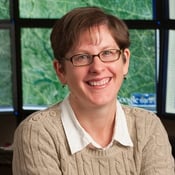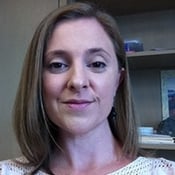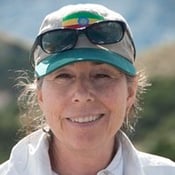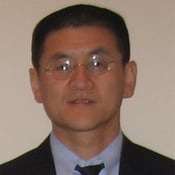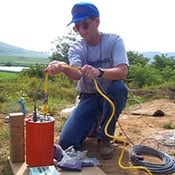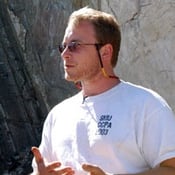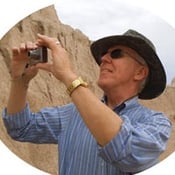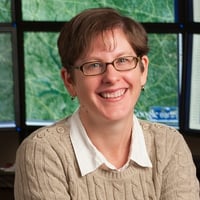We’ve all witnessed, sometimes first-hand, the effects of climate change —these include increasing numbers of extreme and disastrous weather events, shrinking glaciers, rising sea levels, and global temperatures to name just a few. We also witness the consequences of geologic processes: earthquakes, volcanic eruptions and landslides. A deep appreciation of Earth Science inspires us to become better stewards of our planet.
To address the most pressing environmental issues of our day and to offer immediate and long-term research-based solutions for geohazards, resources, and climate issues of national and international interest, dedicated professionals with a deep knowledge of the Earth Sciences are needed. Expertise in the Earth Sciences, which address the complex interactions among the physical and biological components of our planet, incorporates cutting-edge research leading to feasible solutions.
SMU offers Ph.D.’s in both Geology and Geophysics, which aim to equip graduates with expertise in their specific area of interest. This resource highlights the value of Earth Science, details current research among SMU Earth Sciences faculty members, describes the different research areas available within the Earth Sciences discipline, and discusses career options available to a Ph.D. professional in this field.
Why Earn a Ph.D. in an Earth Sciences Discipline?
Earth Science is the study of the Earth, planets, climate, and environment, of how they have changed in the past, how they are changing now, and how they will be affected in the future. It is now part of a continuum of studies that spans from the origin of the universe through to the evolution of our planet and of our species. Earth Science seeks to characterize natural and anthropogenic hazards, their causes, and identify ways to reduce their impact on our societies. Earth scientists also work to find new and sustainable resources, and conduct important research for national and global security.
The development of human culture since the last glacial maximum enabled our species to become a significant geologic force. Humanity has the capability to perturb the geologic cycles that sustain life of Earth. Many contemporary societal problems have their roots in geology. There is an increasing need for research with knowledge of the Earth Sciences' most pressing issues, and a passion for developing actionable insights and solutions.
Choosing to pursue a Ph.D. in an Earth Science discipline provides the training and the background to carry out evidence-based research on complex problems.
Earth Science is essential to understanding the greater framework of life and planetary evolution, beginning with the origin of the universe, the development of plate tectonics, and continuing through to recognizing humans as a major force shaping the surface of the planet today.
For example, when holding a rock found at the surface of the Earth, we can ask about its origin, provenance, and age. Its physical properties, trace elements, and isotopes may tell us that the rock probably came from the mantle at a particular depth. The information about the mantle, in turn, reveals how the planet differentiated from primordial material, now preserved in meteorites found on the Earth’s surface. The concentration of noble gases and stable isotopes in the rock provide insights into the history of the atmosphere, hydrosphere, and biosphere of the planet. Ultimately, every rock, fossil, or ancient soil tells a story about the complex interactions of rock, water, air and life, and modern technology allows to study the Earth now using information about the planet gleaned from the past.
Students who choose to pursue a doctoral degree in an Earth Science discipline are able to explore and research these areas and more. If you are interested in learning more about the latest research from the field, what careers are available to those who choose to earn their doctoral degree in Earth Science, and what it’s really like to complete a Ph.D. in this exciting and ever-evolving field — read on!
Discovering Your Planet: A Complete Guide to Earning a Ph.D. in Earth Sciences
 Access the guide at any point by saving it to your laptop to reference while you navigate applying to graduate school.
Access the guide at any point by saving it to your laptop to reference while you navigate applying to graduate school.
Receive this resource as an eBook!
EXPLORING THE LATEST RESEARCH IN EARTH SCIENCES
Students who choose to pursue a Ph.D. do so because they want to develop new ideas that, when investigated, lead to new knowledge on fundamental problems within their discipline. But, what exactly does research in the field of Earth Science look like?
Research within a Ph.D. program in an Earth Science discipline is flexible and can generally reflect any passion the particular student has. For example:
- Spend your days hiking over rocks in remote areas across the world like Dr. Rita Economos, Dr. Robert Gregory, Dr. Neil Tabor, and Dr. Bonnie Jacobs.
- Explore the world around you on a research vessel like Dr. Matt Hornbach and Dr. Maria Beatrice Magnani.
- Focus on your work in a state-of-the-art geochemistry lab like Dr. Crayton Yapp and Dr. Economos.
- Get your hands dirty digging holes for instrumentation and collecting your own seismic data like Dr. Heather DeShon and Dr. Magnani.
- Work with satellite data focused on the Earth and other planets like Dr. Zhong Lu.
- Develop advanced programming and instrumentation to study the geosphere and atmosphere with seismic and infrasound waves, and apply these techniques for global security like Dr. Brian Stump and Dr. Stephen Arrowsmith.
- Discover new fossil sites to understand how climate and ecology have changed over the course of Earth history like Dr. Bonnie Jacobs.
Whatever your passion within the field of Earth Science, by earning your Ph.D. you are opening up doors to exciting opportunities filled with collaboration and teamwork with expert professional colleagues, and worldwide travel for research, experimentation, and information gathering.
Meet SMU’s Earth Sciences Faculty Members
Stephen Arrowsmith
Associate Professor, Hamilton Chair
Ph.D., University of Leeds
Area of Interest: Seismology and infrasound, signal processing, numerical modeling
Heather R. DeShon
Associate Professor
Ph.D., University of California — Santa Cruz
Area of Interest: Earthquake seismology, tectonics of convergent margins, earthquake and volcano hazards, induced seismicity.
Rita C. Economos
Assistant Professor
Ph.D., University of Southern California
Area of Interest: Igneous petrology, zircon geochemistry and geochronology, tectonics associated with magma emplacement
Robert T. Gregory
Professor, Department Chair
Ph.D., California Institute of Technology
Area of Interest: Stable isotope geology and geochemistry, evolution of earth’s fluid envelope and lithosphere, Archean greenstone belts, ophiolite emplacement and fluid-rock interaction
Matthew Hornbach
Professor
Ph.D., University of Wyoming
Area of Interest: Heat flow, fluid flow, marine geophysics, Reflection seismology, natural hazards, methane clathrate development
Bonnie F. Jacobs
Professor
Ph.D., University of Arizona
Area of Interest: Paleobotany, paleoecology, and paleoclimates of the Cenozoic, tropical and subtropical climate change
Zhong Lu
Professor, Shuler-Foscue Chair
Ph.D., University of Alaska
Area of Interest: Radar remote sensing, interferometric SAR (InSAR), deformation modeling, natural and human-induced hazards with a focus on volcanoes, subsidence and landslides
Maria Beatrice Magnani
Professor
Ph.D., University of Perugia, Italy
Area of Interest: Active source seismology, continental tectonics, natural and anthropogenic hazards, intraplate faulting and earthquakes
James E. Quick
Associate Provost for Research and Dean of Graduate Studies
Ph.D., California Institute of Technology
Area of Interest: Igneous and metamorphic petrology, tectonics, volcanology, ultramafic massifs and supervolcanoes
Brian W. Stump
Professor, Albritton Chair
Ph.D., University of California–Berkeley
Area of Interest: Earthquake and explosion seismology, infrasound and seismic waves, instrumentation, induced seismicity
Neil J. Tabor
Professor
Ph.D., University of California–Davis
Area of Interest: Sedimentology, paleosols, stable isotopes, paleoclimate, paleoclimatology
Crayton J. Yapp
Professor
Ph.D., California Institute of Technology
Area of Interest: Stable isotope geochemistry, paleoclimatology, iron oxide geochemistry, terrestrial paleoclimates
A Look at Current SMU Faculty Research Projects
Dr. Maria Beatrice Magnani — Solid Earth response of the Patagonia Andes to post-Little Ice Age glacial retreat
Dr. Maria Beatrice Magnani — Solid Earth response of the Patagonia Andes to post-Little Ice Age glacial retreat
Dr. Magnani’s research focuses mainly on the study of continental lithosphere formation and evolution through active source seismic investigation, both on land and marine. Investigating the continental lithosphere poses an exceptional challenge because unlike the oceanic lithosphere, the continental lithosphere does not have a common mode of origin, as it is an assemblage of diverse compositional elements with different thermal and tectonic histories.
One of her latest projects focuses on the interaction between solid Earth tectonics and surface processes. The goal of this National Science Foundation project is to understand how the Earth responds to a cryospheric mass imbalance on a time scale of centuries in the well-monitored region of the Southern Patagonian Andes, an area of complex Neogene ridge subduction and youthful volcanism. The problem of glacial isostatic adjustment (GIA) is an important problem and critical to understanding the viscosity and time-scales of deformation in the upper mantle. The team of researchers from SMU and other universities will try to quantify and model the isostatic response to ice and sediment loading and unloading. A primary driver of modern rock uplift beneath and surrounding the Southern Patagonia Icefield (SPI) is interpreted to be ice loss following the peak advances of the Little Ice Age (LIA). Recent geodetic studies reveal remarkably rapid uplift rates (up to 40 mm/yr and averaging ~20 mm/yr around the SPI). These rates are the fastest modern geologic uplift rates; ones that demand a low viscosity mantle. In Patagonia, the presence of a somewhat poorly understood slab window that developed during Late Cenozoic time supports speculation that a low-viscosity zone underlies the region where GIA is very rapid. [Revised from an abstract taken from NSF document]
Dr. Matthew Hornbach — Fluid and Heat Transport
Dr. Matthew Hornbach — Fluid and Heat Transport
Dr. Hornbach’s research focuses primarily on understanding fluid and heat transport in the Earth. To conduct this work, he integrates theoretical and numerical approaches with experimental data. Many of the instruments and software used to collect these data are built by researchers in-house in his lab. His group works at SMU’s Geothermal Lab addresses a broad range of societally relevant earth science problems that include basin evolution, fluid/pressure/heat transport, sediment strength and slope stability, geothermal energy potential, and induced seismicity.
Much of the research conducted at the SMU Geothermal lab involves measuring heat flow and fluid transport in complex onshore/offshore sedimentary basins. These studies have been used to assess not only regional subsurface temperatures but thermal evolution, geothermal energy potential, and chemosynthetic life on the seafloor.
Funded by the National Science Foundation, and collaborating with German Colleagues on the R/V Meteor, Hornbach’s research team deployed and tested a new type of heat flow sensor this past spring called the POrtable GeOthermal Gradient Probe (or “POGO Probe”). This new probe worked flawlessly and is able to collect and download heat flow data in a fraction of the time compared to conventional heat flow tools. Measured obtained from the Lesser Antilles Arc using this probe have found the highest heat flow on record along the Arc (>400 mW/m^2), demonstrating both where subsurface volcanism exists, and the geothermal energy potential in the Caribbean.
Dr. Neil J. Tabor — Insights into the Tempo, Effects, and Causes of the End-Permian Mass Extinction
Dr. Neil J. Tabor — Insights into the Tempo, Effects, and Causes of the End-Permian Mass Extinction
Dr. Tabor is a sedimentologist and sedimentary geochemist and Fellow of the Geological Society of America. His research focuses on paleosols, or ancient soils, and using the chemical information stored in the sedimentary record to extract value data on past climates and ecology.
Major mass extinctions have occurred at various times throughout Earth history. The most well-known of these happened with the demise of the dinosaurs at the end of the Cretaceous Period, but it is believed that the largest mass extinction happened at the end of the Permian Period, approximately 252 million years ago. The extinction in the marine realm was global and occurred over a relatively short time interval. However, events in the terrestrial environment are only sparsely documented. This project will examine well-exposed sedimentary rock successions that formed in lakes, rivers, and ancient soils during the time of these extinctions. This research will enable precise documentation of the sequence of events on land, a comprehensive analysis of the environmental changes that took place before, during and after the event, and an investigation of how terrestrial animals and plants responded to these changes. The results will determine if extinctions on the continents occurred at the same time as those in the ocean and what conditions existed that may have caused such large-scale changes. Given current concern about rates of extinction, knowledge of the processes that occurred in the past will help identify the reasons behind major changes in flora and fauna. The project will develop museum exhibits and outreach programs to inform both educational and general audiences. [Abstract taken from NSF document]
Research Areas within Earth Sciences
Within the broad field of Earth Science, Ph.D. candidates may choose to focus on any one specific area of research. Current and past SMU Ph.D. students have concentrated their research on one of the following areas:
Aqueous Geochemistry

Students considering problems in aqueous geochemistry typically combine laboratory and fieldwork with a theoretical analysis. Some of the topics considered in the department include the nature of fluids during paleoclimate reconstructions, the water cycle, urban surface water compositions and characterization of reactions at the mineral/solution interface. Students can make use of equipment in the wet geochemical lab to measure the concentration of elements in solution and the electron microprobe lab to look at elemental concentrations and zoning patterns in minerals.
Geology

Geology
Geology is the study of our earth and its history — it provides a new understanding of our physical environment, resources and our place in its evolution. This research focus is of particular interest to those that would like to apply principles from other sciences, mathematics, and engineering to understand the world we live in. Outdoor studies of rocks in the field are an integral part of geological studies.
Geothermal Energy and Heat Flow

Geothermal Energy and Heat Flow
Geothermal energy is a renewable energy source generated by the Earth's internal heat. Most of the world's geothermal energy is concentrated along plate boundaries and hot spots. Supplying reusable energy for the increased worldwide energy demand, the use of geothermal energy does not require fossil fuel burning; therefore, present research of heat flow and future developments of geothermal energy will largely impact the many generations to come.
Paleoclimates

Paleoclimates
Research involves both biogenic and abiogenic materials to estimate climates of the past. Geochemical analyses assess chemical, mineralogical, and energy properties in order to relate them to environments throughout geological time. Paleobotanical remains, which may also be characterized through isotope geochemistry, are analyzed for their taxonomy and (in the case of leaves) their shape to infer past climate. The laboratories rely upon intensive fieldwork for sample acquisition and then undertake detailed characterization of those samples to understand their contents and history. Frequently used geochemical analytical methods include petrography to understand depositional textures; X-ray diffraction to understand the occurrence, abundance, and distribution of minerals; X-ray fluorescence to evaluate the distribution of chemical compositions among samples; and stable isotope measurements of carbon, oxygen, and hydrogen isotopes to infer environmental conditions at the time of formation.
Sedimentology

Sedimentology
Sedimentology considers the production, transport, deposition and lithification of chemical elements, ions, and compounds through Earth’s near-surface environments. Through an analysis of landscape position and different transport media such as gravity, wind, water and ice, different scenarios that include erosion, transport, deposition, compaction and cementation are used to relate sedimentary systems to the energy that is applied to near-surface environments. This is concept is reinforced through study of modern marine, riverine, lacustrine (lakes), glacial and eolian (wind-dominated) modern environments, and then applied to interpretation and reconstruction of ancient environments from analysis of sedimentary deposits through lecture, laboratory, and field trip exercises.
Stable Isotope Geochemistry

Stable Isotope Geochemistry
The stable isotope ratios of light (H, C, O,) elements vary greatly in nature and can be used to understand geological and biological processes. In particular, stable isotopes are potent tools for understanding, fluid-rock interactions, tracing the hydrologic cycle, paleoclimatology, and ecosystem ecology as well as paleothermometry. The research program at SMU stresses the evolution of the Earth's fluid envelope and lithosphere. Current projects address diverse topics ranging from the origin of quartz veins in the continental crust to the climate history of the Earth. Interaction of seawater with the cooling oceanic crust at mid-ocean ridges are being investigated as well as anthropogenic inputs of CO2 into the atmosphere. The isotopic concentrations in goethite (a-FeOOH) and hematite (a-Fe2O3) are being measured to understand levels of O2 and CO2 in paleo-atmospheres.
Environmental Science

Environmental Science
SMU students who choose to focus their research on environmental geology develop the tools necessary to address urgent problems facing humankind today: contamination of our underground water supply, river flooding and earthquakes, holes in the ozone layer, acid rain, smog, burial of toxic wastes, landslides, hurricanes, coastal hazards, global warming, and preservation of ecosystem diversity. We need a growing number of people with the training and background to understand the biological, toxicological, physical, and chemical aspects of environmental processes, as well as the relevant political, social, and legal considerations.
Geophysics

Geophysics
Geophysical techniques are used to understand the physical behavior of planet Earth, including plate-tectonic processes, earthquake mechanisms, and nuclear test-ban verification. Those who chose to pursue research in the area of Geophysics will have a strong quantitative background in seismology, geothermics, tectonics, and digital signal processing.
Remote Sensing

Remote Sensing
Satellite radar provides an all-weather, day-and-night imaging capability for imaging landscapes and monitoring their changes. Through interferometric synthetic aperture radar (InSAR) techniques, satellite radar imagery can be used to measure ground surface deformation and map land surface characteristics at high spatial resolution. The unprecedented spatial resolution of surface deformation measurements from InSAR allows the exploration of various geophysical models and the associated source parameters to understand the causal mechanisms. Applications of InSAR include the study of volcano, landslide, and human-induced geohazard processes (mining, CO2 and wastewater injection, hydrocarbon extraction, sinkhole, ground fissure, etc.).
Paleontology

Paleontology
The objective of paleontological studies at SMU is to apply fossils to understanding significant issues in Earth and life history, including the evolution of communities and ecosystems, and assessment of past climates. Students are encouraged to take a global perspective. Interdisciplinary and international studies are encouraged and have included field areas in both East and western Africa, Texas, and the U.S. Southwest. Particular strengths lie in, systematics, taphonomy, and paleoecology of terrestrial ecosystems, with particular focus on the intersection of geological and biological processes in tropical Africa during the past 66 million years. Students utilize innovative approaches and benefit from departmental strengths in paleoclimatology and stable isotope geochemistry. Current geographic areas of study include Alaska, Texas, Angola, Antarctica, China, Democratic Republic of Congo, Ethiopia, Kenya, Tanzania, Mongolia, Mozambique, Cameroon, Pakistan, and Portugal.
Seismology & Infrasound

Seismology & Infrasound
Seismology and infrasound studies at SMU span the land, sea and atmosphere. Faculty expertise includes earthquake seismology, explosion source studies, infrasound and exploration seismology methodologies. SMU faculty have globally recognized expertise in data collection and archiving. SMU operates over 200 channels of real-time seismic and acoustic data and leads large land-and-water based acquisitions. Current projects include monitoring human-induced earthquakes in north Texas, exploring methane hydrate stability in the North Sea, and using marine seismology techniques in high-elevation Patagonia to constrain uplift rates. Unique to SMU, instrumentation developmental work consists of seismic and acoustic array design and deployment including the TXAR (Texas), NVAR (Nevada), and South Korea seismo-acoustic arrays relevant to seismic verification of nuclear arms-control treaties and monitoring.
Tectonics and Structural Geology

Tectonics and Structural Geology
Tectonics is the study of the deformation of rocks, of Earth’s materials and the forces that produce such deformation. Structural Geology studies the structures formed by those forces (e.g., folds and faults), and together these two fields explore the processes that build mountains, create oceans and basins, and rule the igneous and metamorphic processes of our planet. At SMU current projects in Tectonics and Structural Geology focus on the evolution of the Eastern North American Margin (ENAM), on the isostatic adjustment of the Patagonian Andes, and on using the Mississippi River channel response to detect intraplate active fault deformation.
Leading Faculty: Meet the Earth Science Experts at SMU
Dr. Stephen Arrowsmith, Associate Professor
What courses do you teach at SMU and how long have you been teaching here?
What courses do you teach at SMU and how long have you been teaching here?
I’ve only been at SMU about half a year and recently taught my first course, which was a graduate seminar class titled ‘Big Data in Seismology’. We explored an emerging trend in seismology where seismologists can now measure the entire seismic wavefield across a small region using really large numbers of standalone sensing nodes. We developed and applied state-of-the-art methods in class to detect new earthquakes in Oklahoma. I’ve worked outside academia for most of my career and, maybe because of that, I’m a big believer in developing classes that not only cover core theory but also the application to real data and exposure to state-of-the-art methods. To me, acquiring knowledge is less important than developing the skills to learn, synthesize, apply, and create knowledge. My goal is to develop classes that really help students with all these skills.
What initially interested you in teaching on a graduate level? What brought you to SMU?
What initially interested you in teaching on a graduate level? What brought you to SMU?
Prior to SMU, I worked at the National Laboratories (Los Alamos and Sandia) for 12 years on a range of problems related to international nonproliferation and defense. I thoroughly enjoyed my work at the labs but felt like I wanted a change. Because I’d really enjoyed working with summer students at the labs, I was interested in teaching. I also felt like I had gained skills and experience from my time at the labs that could benefit students. Because I’ve not been in academia my whole career, I felt like I could offer students a different perspective. SMU has been a leader in seismology and infrasound for nonproliferation for decades, and I have worked with several of the faculty and staff for many years. There was really no other university I’d have rather come to at this point in my career!
What do you think is most unique or valuable about the Earth Sciences Department at SMU?
What do you think is most unique or valuable about the Earth Sciences Department at SMU?
The Earth Sciences department at SMU is small, but a really close-knit group. I think that this means that the graduate students get a much broader education and exposure to different aspects of Earth Sciences than they would at larger departments, where research groups tend to be more compartmentalized. A lot of our students work with multiple faculty, and with students who have different research interests. Our department also specializes in a few strategic areas. One of the reasons I came here is because SMU is really well known internationally for seismology and infrasound. I think that by specializing in a few areas, we can punch above our weight in terms of our impact on research.
What area of research do you specialize in within the field of Earth Science?
What area of research do you specialize in within the field of Earth Science?
I’m really known for my work in infrasound, which is sound at frequencies below what we can hear. I study how infrasound is generated by natural and human sources (e.g., volcanoes, meteors, explosions, aircraft), how that sound propagates through the atmosphere, and how we can measure and process infrasound data. I also work in seismology and have worked on developing new methods for processing seismic data, especially large datasets which are becoming more common.
Are there any emerging trends or developments in the field of Earth Science that you find exciting?
Are there any emerging trends or developments in the field of Earth Science that you find exciting?
There’s a big revolution in sensing right now that’s enabling us to make a whole bunch of new types of measurement (e.g., using drones to measure volcanoes) and to make much larger volumes of measurements (e.g., we can deploy thousands, instead of tens, of seismometers to measure earthquakes in a region). These new types of measurements can help us study Earth’s processes that we simply couldn’t capture or resolve before. For example, I’m looking at how we can detect small earthquakes using dense networks that were not able to detect before. This enables us to map new faults, better understand stress distributions and seismic hazard, and image the crust more precisely. Another revolution I’m really excited by is the advances in High-Performance Computing, and how that is changing what we can do with Geophysics.
What courses do you teach at SMU and how long have you been teaching here?
What courses do you teach at SMU and how long have you been teaching here?
At SMU, I teach a broad range of classes spanning non-major undergraduates through advanced graduate courses. At the non-majors undergraduate level, I teach a general education survey course Earthquakes & Volcanoes. For majors in Earth Sciences, I teach a practical course Computer Methods in Earth Sciences and the overview course Introduction to Geophysics. At the graduate level, I teach Introduction to Seismology and Geophysical Inverse Theory.
What initially interested you in teaching on a graduate level?
What initially interested you in teaching on a graduate level?
A good graduate-level course benefits the faculty teaching it as much as the students taking the course. You don’t really understand the limits of your own understanding of a topic until you teach it. My graduate courses all contain a term project that requires the students to apply and critically think through the results of the theory to their own research topics. In this way, I learn quite a bit about what all of the graduate students work on and they learn what interests their peer cohort. Again, this leads to improved outcomes and students that can think broadly within the discipline.
What do you think is most unique or valuable about the Earth Sciences Department at SMU?
What do you think is most unique or valuable about the Earth Sciences Department at SMU?
The SMU Earth Sciences Department has always emphasized outstanding research and teaching in fundamental research topics of national or educational importance. The Department also favored overlapping faculty interests to build depth within specific subdisciplines (paleo-studies, geochemistry, geophysics) with a more limited number of faculty members. The result of this vision is that SMU Earth Sciences faculty include nationally and internationally recognized scientists working together on important and societally relevant research that can be brought into the classroom from our non-majors courses through to our Ph.D. program.
What research have you been involved in at SMU or elsewhere? Do you have a favorite research project?
What research have you been involved in at SMU or elsewhere? Do you have a favorite research project?
I have been researching the North Texas earthquakes. I also love researching and understanding large subduction zone earthquakes, like the 2011 Japan earthquake.
In 2013, the town of Azle in the Dallas-Fort Worth metropolitan area experienced a series of magnitude 3.5 earthquakes. These were not the first nor the last earthquakes but the events spurred a new direction to my own research that continues to excite me because it is so important to the Dallas region. The US Geological Survey asked seismologists at SMU to help deploy seismometers near Azle to better estimate earthquake location and assess the cause. The cause was quite important because since 2009 the central US had experienced a near exponential increase in earthquakes and by 2013 most people suspected a direct link to oil and gas production and allied wastewater disposal. At SMU, we deployed more than the USGS seismometers – we eventually extended the seismic network to 40 stations and began a large collaboratory research project spanning 6 faculty members’ laboratories (DeShon, Hornbach, Magnani, Stump, Lu, Gregory). The faculty and our students and research staff worked together to provide near real-time information to the Dallas-Fort Worth community and produced important peer-reviewed publications showing how earthquakes in the Fort Worth shale gas basin are physically linked to wastewater disposal. I am proud that our department’s effort has helped the community better understand seismic hazard and spurred regulatory changes and the creation of a Texas Seismic Network, now operated out of the Bureau of Economic Geology using state funds.
Why do you think Earth Sciences is an important and valuable field to study?
Why do you think Earth Sciences is an important and valuable field to study?
We live and interact with the planet. Our technology requires minerals, our homes require rock and wood, we are reliant on oil products (gas, plastics, etc), our food requires water. Humans change the planet and the planet’s dynamic systems interact in complex ways. Earth science is the integrative and highly practical study of these systems. My own research interest focuses on better determining seismic and tsunami hazard and hence allow better risk determinations for the public living near faults, volcanoes, the oceans, etc. However, any Earth scientist would be ashamed to not mention that we must understand and mitigate climate change and provide accurate data to assess how a changing climate, in turn, affects water resources and sustainability.
Career Paths Available With A Ph.D. in an Earth Sciences Discipline
Earning your Ph.D. in the Earth Sciences opens doors for a number of career opportunities in academia and working for government agencies or private companies. Whatever your particular area of interest, your Ph.D. will allow you to earn a competitive salary while qualifying for cutting-edge research and the best positions in the field. Depending on your specific doctoral degree and research specialization, job opportunities include geophysicist, geologist, hydrologists, paleontologist, and more.
The Ph.D. program in Earth Sciences consists of 20 graduate students and is well designed to train candidates with critical thinking skills and equip them with state-of-art techniques and data analysis methods. All SMU Ph.D. students within the Earth Sciences department will be able to find desirable jobs before or shortly after graduation.
Due to the increased need for energy, environmental protection, and responsible land and resource management, the Bureau of Labor Statistics projects that there will be greater demand for geoscientists in the future. Additionally, the career outlook for geoscientists is excellent as jobs are projected to grow 14 percent from 2016 to 2026, faster than the national average for all occupations. The chart below offers several insights into popular careers within the Earth Sciences discipline.
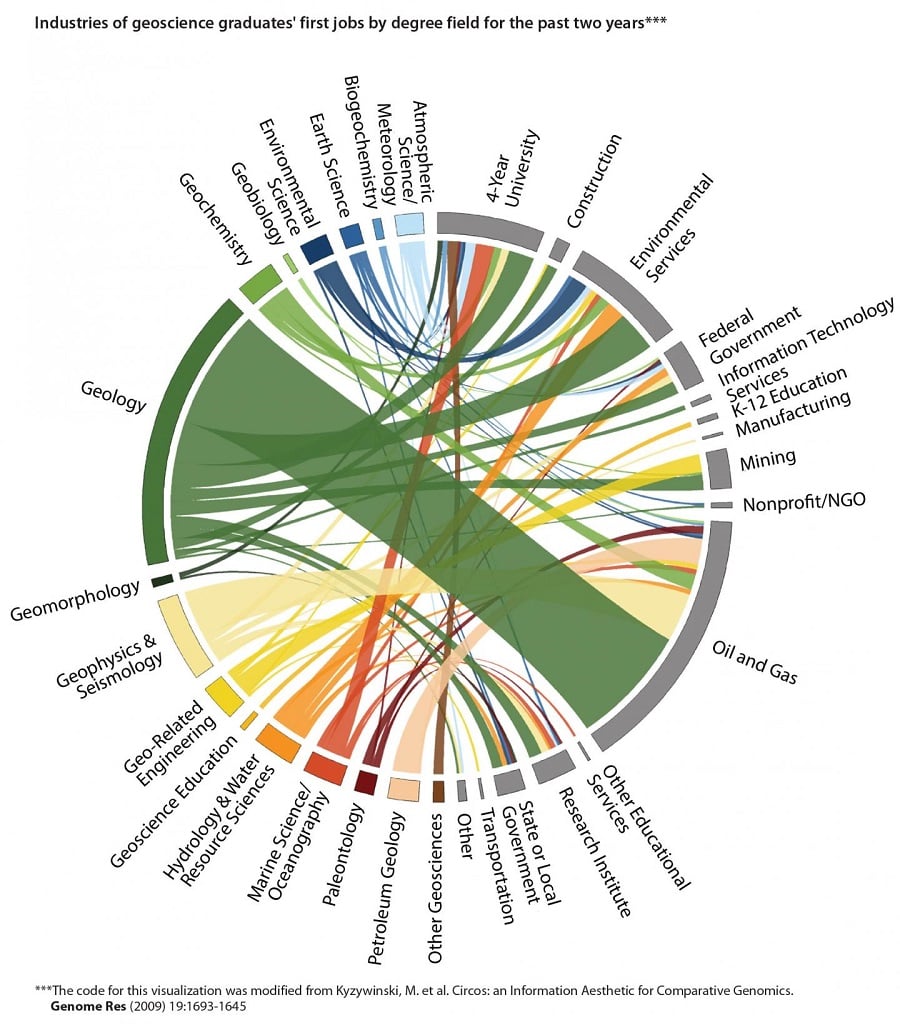
Source: AGI
REQUEST MORE INFORMATION
Want to learn more about SMU’s Ph.D. programs in the Earth Sciences?
Contact us today, we will be in touch!
Careers in Academia
Ph.D. graduates who pursue a career in academia most frequently find employment as a university professor, researcher, or instructor. Many students who choose to work in academia pursue tenure-track positions because of their job security and higher pay. These careers include a combination of teaching, student advising, and continued research. Depending on the geographic location and whether the institution is a public or private university, salary ranges for academic positions can vary considerably. Working in academia with your Ph.D. you can expect to make between $90,101-$127,572 per year depending on whether you are hired for a full-time or associate position.
Careers in Government Agencies
Ph.D. graduates who pursue a career with a government agency most frequently find employment with the United States Geological Survey (USGS), NASA, National Oceanic and Atmospheric Administration (NOAA), Environmental Protection Agency (EPA), or other national laboratories. Careers in government agencies and laboratories are focused primarily on research, reporting, fieldwork, and data-gathering, as well as identifying trends and making predictions based on their findings. On average, geoscientists can expect to make $91,130 or more annually.
Careers in Private Companies
Ph.D. graduates who pursue a career in a private company are needed to perform research and consulting. Careers working for private companies can include petroleum geologist, geophysicist, petrophysicist, and environmental geologist to name a few. Similar to careers with government agencies, these jobs offer the opportunity for field research, data acquisition and interpretation, reporting, and making predictions and recommendations based on your findings. Another job aspect that is common in private companies is the opportunity for consulting in your area of expertise. Average salaries for these kinds of careers vary based on position and experience, but on average those holding a Ph.D. can expect to make well over $100,000 annually with more competitive salaries for those with a few years of professional experience.
Learn More About the Earth Sciences Department at SMU
Earth Sciences is a core discipline in Dedman College at SMU and offers students the opportunity to ponder some of the most pressing issues of our day including climate change, natural resources, and the threat posed by hazards to our environment. Earth Sciences was one of SMU’s first Ph.D. granting departments, and has a long-standing history of distinguished faculty, forward-thinking students, and alumni. Housed within the Roy M. Huffington Department of Earth Sciences at SMU, candidates may pursue one of two doctoral degrees — a Ph.D. in Geology or a Ph.D. in Geophysics.
SMU’s Ph.D. programs are research-based and coursework is designed to foster research progress and provide interdisciplinary breadth within the field, as some of our student’s best ideas come from outside their specialty. In many cases, courses at the graduate level are tailored to the cohort or individual students needs. At SMU, Ph.D. students are equipped with a learning and mentoring environment that allows them to explore their own research questions and meet their own career goals in collaboration with the faculty, research staff, and other graduate students. Doctoral research is expected to be of the highest quality, published in the peer-reviewed literature, and presentable at major professional meetings in the US and internationally.
Students are able to tailor their coursework and experiences within the Ph.D. program to align with their own individual interests. With only two required courses, students are free to choose their remaining elective courses with the help of their committee. To ensure the doctoral candidate is on the right track, students meet with their committee once or twice a year.
ADVANCING THE FIELD:
Stories and Resources for Graduate Students
Advancing the Field is a weekly blog that offers prospective graduate students insight and advice as they consider the challenges and exciting possibilities that come with getting a graduate degree.
Subscribe to the Blog Today!
Understanding the Unique Features of SMU’s Earth Sciences Department
SMU’s doctoral programs within the Department of Earth Sciences are widely recognized as competitive, cutting-edge, research-based programs with a tradition of faculty expertise, close student/mentor collaboration, and international recognition. The faculty members and graduate students within the department have received funding from prestigious organizations such as the U.S. Departments of Defense and Energy, NASA, and the National Science Foundation. The department has also achieved international recognition in the research areas of seismology, geothermal studies, and paleoclimatology.
The SMU Earth Sciences Department has always emphasized outstanding research and teaching in fundamental research topics of national or educational importance. To build depth within specific subdisciplines, such as paleo-studies, geochemistry, geophysics, and natural hazards, the department has favored overlapping faculty interests. As a result of this vision, the SMU Earth Sciences faculty include nationally and internationally recognized scientists working together on important and societally relevant research that can be incorporated into the classrooms from our non-major courses through to our Ph.D. program.
When I think about [SMU’s] characteristics, I think of our modest size with opportunities for students to work collaboratively with multiple faculty. This characteristic provides an opportunity for our students to develop a breadth of skills and problem-solving tools. Additionally, we engage outside intellectual resources in each student's program including their participation in the peer review process as well as engaging outside committee members from industry, academia, and other research institutions.— Dr. Brian W. Stump, Professor of Seismology
Also unique to the department is the community involvement of both faculty and graduate students. The department motto is “Earth Science research in the national interest.” However, the department has also taken on research of regional interest, such as operating seismic stations to understand earthquakes affecting the Dallas-Fort Worth metropolitan area. Our faculty, graduate students, and alumni can be found speaking and presenting research throughout the regional area including the Perot Museum of Nature and Science, local K-12 classrooms, local businesses, and community groups.
Meet a Current Graduate Student: Their Take on Earning a Ph.D. in the Earth Sciences

Julia McIntosh, Ph.D. student
Tell us a little about yourself!
Tell us a little about yourself!
I was born and raised in Austin, Texas and went to college at the University of Texas at Dallas (UTD) under an academic scholarship to study bioengineering. After my first year, I realized I was bored with my engineering classes and needed to make a change. My father, a geophysicist at the University of Texas at Austin Institute for Geophysics, encouraged me to take a geology class (because “it will be fun”). I had always envied his travels, which took him all over the world, where he studied fascinating things, met new people, and ate new things. Thus, I agreed to take an introduction to geology course (because “why not”). By the end of it, I finally understood why people like my father chose this as a career path.
Not only is the lifestyle of a geologist interesting, but geology is too. This feeling was only intensified after a summer field course in Colorado where I excelled in developing stratigraphic columns and depositional environment interpretations. Following the course, the professor who taught it, Dr. John Geissman, asked me if I would consider working in his lab as a lab assistant. I enjoyed collecting geomagnetic data, and I eventually asked him if I could work on my own research project, to which he agreed. I went on to receive my B.S. in Geosciences at UTD in 2016 with a concentration in paleomagnetism.
Why did you choose the Earth Science Ph.D. program at SMU?
Why did you choose the Earth Science Ph.D. program at SMU?
When I was looking for potential graduate advisors, I looked for people that studied stratigraphy, sedimentology, and climate questions. These were the topics that I enjoyed studying during my undergrad years. I also wanted to stay in Texas because my dad was sick, and I wanted to be able to drive home to Austin frequently to help and be with my family. I happened across Dr. Neil Tabor here at SMU and sent him an email. It turns out, he and my undergraduate advisor, Dr. Geissman, were colleagues who frequently collaborated. I later found out that they talked about me at length and mutually decided that I would be a good fit for Dr. Tabor’s lab group. I received an acceptance email from SMU, with a decent financial package, and I decided to take it. I was initially accepted as a master’s student, which I completed in 2018, but became enthralled by the work that we were doing in the lab. I eventually asked Dr. Tabor if he would take me on as a Ph.D. student. He was tentative at first (he wanted to make sure we got along; 6 years working alongside one another is a commitment) but eventually he said he would take me on as a Ph.D. student if I went on a research trip with him to Antarctica. I couldn’t say no.
Now that you’ve experienced the program, what’s your favorite part about it?
Now that you’ve experienced the program, what’s your favorite part about it?
This program has been challenging from the beginning, particularly while taking classes like Stable Isotope Geochemistry with Dr. Yapp. However, during that class, I formed a bond with my fellow classmates, that made the class, and grad school, a little less soul-crushing. It is mutually beneficial to be friends with other grad students, because your other friends or family, who work normal jobs and normal hours, will not understand your different path. Moreover, not only do other students understand and provide support, but you learn from one another. Plus, once you have the opportunity to teach someone something, you have a better understanding of it yourself. Overall, the people I have met have made this experience far better than I could have predicted.
What achievement, project, or experience are you most proud of from your years in graduate school?
What achievement, project, or experience are you most proud of from your years in graduate school?
I am most proud of my performance and experience in Antarctica. It was one of the best experiences of my life, but also one of the most challenging. My advisor and I traveled to a remote research camp in the Central Transantarctic mountains to study and sample Permian-Triassic aged stratigraphy, while others in our group searched for pre-dinosaur, mammal-like reptiles. We were “on the ice” from mid-November to late January, with no cell phone service, no internet, only a satellite phone for infrequent calls. It was a very isolating experience, where all we had was our work and each other. However, things began to turn around during late December when I had discovered one of these mammal-like reptiles called a Procolophon.
This was an important discovery because it was likely higher up in the stratigraphy than had previously been found, i.e. it had survived, or evolved, into the middle Triassic, instead of the previously determined early Triassic. I also discovered plant index fossils and a Permian-Triassic boundary section. This led to many other paleontological discoveries, while I recorded and sampled the lithologies in hopes of later reconstructing the high-latitude Permian-Triassic paleoenvironment using geochemical methods. My team commended my attention to detail and were thrilled by the results of this arduous venture. Overall, my success in Antarctica also turned out to be a good networking opportunity, such that I was subsequently invited to do fieldwork in Argentina and Zambia with other scientists on differing projects.
What are your career dreams or plans? How has the Earth Sciences Ph.D. program at SMU helped prepare you for your future?
What are your career dreams or plans? How has the Earth Sciences Ph.D. program at SMU helped prepare you for your future?
During my last year at SMU I plan to apply for several postdoctoral fellowships so that when I graduate, I have another research position lined up. After a postdoctoral position, I hope to apply for tenure-track professorships.
Working with Dr. Tabor as a researcher here at SMU has required me to advance my critical thinking and scientific writing skills. He has encouraged me to read academic papers, not just for their findings, but also to understand how to develop studies and organize my writing. After teaching me the theory and methods behind the work that he does, Dr. Tabor has also urged me to come up with my own ideas for projects. Lastly, he has also trusted me to travel independently to work with colleagues on varying projects, leading to significant networking opportunities. By allowing me to be independent, while seeking counsel from him throughout my work, Dr. Tabor has prepared me to begin writing my own papers and to develop my own projects. This will help me when I start applying for postdoctoral and other positions, because I will have published several papers, and possibly have a funded project by the time I graduate with my Ph.D.
My time at SMU as a teaching assistant and a researcher has allowed me to develop a strong geochemistry background but also improve my understanding of other tangential subjects. This multidisciplinary training will put me in the position to teach not only geochemistry courses but also sedimentology, stratigraphy, and soil science courses. This will be helpful when applying for tenure-track positions that almost always require teaching.
Admissions and Degree Requirements
The Huffington Department of Earth Sciences at SMU awards competitive research assistantships (RA) and teaching assistantships (TA) to all students admitted to the department for graduate study. Assistantships are provided to outstanding applicants on the basis of test scores as well as past research experience and publication records. Additional fellowships and funding are also available at the university level to highly qualified students.”
Admission Requirements
Admission requirements
The graduate school at the Roy M. Huffington Department of Earth Sciences at SMU requires the following items for application consideration to their Ph.D. programs:
- To receive maximum consideration for financial aid completed applications for admission and financial aid should be received before January 15th (applications received after this date will be considered on a space-available basis).
- An overall grade point average (GPA) of 3.00 on a 4.00 scale and a GPA of 3.25 in the major
- Results from a recent Graduate Record Exam (GRE)
- International students applying from countries where English is not the native language are required to provide scores on the Test of English as a Foreign Language (TOEFL).
For more information, please contact the Director of Graduate Studies, Dr. Zhong Lu, or the Huffington Department of Earth Sciences:
Southern Methodist University
Dallas, TX 75275-0395, USA
geol@mail.smu.edu
Tel: 1-214-768-2750
Fax: 1-214-768-2701
Degree Requirements
Degree Requirements
The Ph.D. degree requires a minimum of two academic years of residency as a graduate student on campus or at a research facility approved by the Department faculty; a satisfactory defense of two original research propositions; and the preparation and public defense of a dissertation that is a significant original contribution to the advancement of science. Students must pass a qualifying exam to advance to candidacy. This generally takes place one to two years into the Ph.D. program. On average, the program takes between four and six years to complete.
To obtain a Ph.D. in Geology or Geophysics, the student must:
- Successfully pass a general qualifying examination.
- Complete a minimum of three years of graduate academic work (48 credit hours minimum), with at least two years of full-time residence on the SMU campus or at a research facility approved by the departmental faculty and the dean of graduate studies.
- Write and make a successful public defense of a dissertation. Additional general requirements for the Ph.D. degree are outlined in the degree requirements the university catalog.
- Satisfy all curricular requirements as specified by the departmental faculty, including three graduate core courses and six dissertation courses.
Connect with SMU
Communities and societies around the globe are relying on educated and passionate individuals to embrace Earth Science research and offer the best solutions for progressing toward environmental restoration and stability. By earning your Ph.D. in Geology or Geophysics, you will be equipped to contribute to those solutions. If you are passionate about the field of Earth Science, we invite you to contact the Department of Earth Sciences and request more information today to learn more about our faculty, research, and Ph.D. degree offerings.
If you know you would like to pursue a Ph.D. in either Geology or Geophysics, we invite you to explore our faculty members’ research pages to see if one of their specific areas of interest aligns with yours. If you find a match, feel free to reach out to them through their department contact information. You can also contact our department’s Director of Graduate Studies, Dr. Zhong Lu, or start an application today. For more general questions, visit the SMU Graduate Studies website or contact Stevie Otto. We wish you luck on your next academic venture!
REQUEST MORE INFORMATION
Want to learn more about SMU’s Ph.D.
programs in Earth Sciences?
Contact us today, we will be in touch!
JUMP TO SECTION
- Why Earn a Ph.D. in an Earth Sciences Discipline?
- Exploring the Latest Research in Earth Sciences
- Leading Faculty: Meet the Earth Sciences Experts at SMU
- Career Paths Available With A Ph.D. in an Earth Science Discipline
- Learn More About the Earth Sciences Department at SMU
- Meet a Current Graduate Student: Their Take on Earning a Ph.D. in the Earth Sciences
- Connect with SMU


